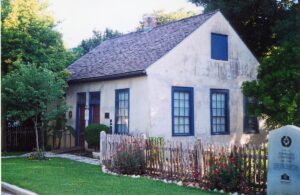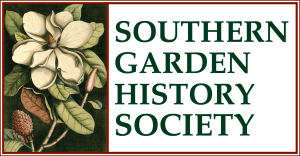
Credit: Wikimedia Commons, “Lindheimer haus, New Braunfels TX.”
Previous Gardens page essays have discussed a large group of designed Southern landscapes. Taking a different direction, this post will examine a large group of people who came to America in the nineteenth century and created a vernacular landscape and distinct culture with which they would become identified…the Texas Germans.
SGHS members have explored this story through talks and writings by native Texan Greg Grant. First came his presentation on the topic at the April 1993 Brenham, Texas, annual meeting, followed by a Summer 1993 Magnolia article entitled “The German Influence on the Texas Landscape.”* Next, Grant addressed German horticultural influences at the October 1993 Old Salem “Restoring Southern Gardens and Landscapes” conference. Further discussion is found in this author’s Fall 2006 Magnolia piece on Frederick Law Olmsted’s Southern travels, which includes reference to time exploring the Lone Star State in 1854 as noted in his Journey Through Texas.**
In brief, early immigration from multiple German states to south-central Texas began in the 1830s. By the 1840s, settlers received encouragement from the Adelsverein organization, having the hope for new beginnings, plus an anticipation of the greater personal freedoms promised by life in the new world.*** Others left Europe after the failure of the Revolution of 1848-49. They would come by the thousands and began to populate an area around such towns as San Antonio. The newcomers included agricultural workers and skilled artisans, along with others who were more highly educated. While some German immigrants became slave owners and others simply opposed abolitionism, many felt strong animosity to slavery. When war came in 1861 their sentiments leaned sharply toward the North, a situation that led to strong disagreements with other Texans and at times to bloody conflict. It was the opponents of slavery, and the well-educated newly minted Texas Germans who most attracted Olmsted in the 1850s.
Having experienced landscapes of enslavement across the South, Olmsted realized something quite different was afoot on first encountering acreage tended by German immigrants. In comparison to the dwellings of “poor whites and slaves,” he noted the “greater variety of crops…and the more clean and complete tillage” seen at the German farms. Olmsted was even more struck by how these recently arrived Texans were tending cash crops, noting the “sensation” he experienced on seeing “a number of parallelograms of COTTON—FREE LABOR COTTON” (The all-capital letters are Olmsted’s in Journey Through Texas.)****
Olmsted offers little insight into how these German farmers engaged in soil preparation, and there is certainly no reference to today’s popular practice of hügelkultur. We might assume, however, that age-old European habits of laying in organic material such as decaying wood into excavated ground might produce larger and healthier results. A desire for improvement was clearly evident among the German town dwellers as well, Olmsted observing in Neu Braunfels (now New Braunfels) that a “horticultural club has expended $1,200 in one year in introducing trees and plants.” The Connecticut-born Olmsted let his regional partialities slip, however, in noting that such “associations are the evidence of an active intellectual life, and a desire for knowledge and improvement among the masses of the people, like that which distinguishes the New Englanders, and which is unknown wherever slavery degrades labor.”
As noted, not all German settlers agreed with Olmsted on the slavery question, one being Ferdinand Lindheimer, known as the father of Texas botany. The long-time editor of the Neu Braunfelser Zeitung newspaper, the university-trained Lindheimer had first lived in Mexico before arriving in Texas in 1835 just as the Texas Revolution was ending. It was in Mexico that his life-long love of the region’s flora was initially kindled, a fact that might remind readers of the twentieth–and twenty-first century Mexico-Texas plant connection crucial to creating the John Fairey Garden referenced in our Gardens post of July 11, 2025. Coincidentally, while not in Olmsted’s circle, Lindheimer developed his own New England link though sending hundreds of plant specimens to Harvard’s famed botanist Asa Gray, leaving an enduring Texas legacy in Massachusetts.
Plans are now being made for a 2027 SGHS Texas annual meeting, again to be based in Brenham. This writer hopes this will offer the opportunity to explore even further the fascinating landscape story of Texas’s nineteenth-century German settlers, along with the heritage they have provided.
************************************************************
*https://southerngardenhistory.org/wp-content/uploads/1993-Summer-Vol.-IX-no.-4.pdf#page=10
**https://southerngardenhistory.org/wp-content/uploads/2015/12/Magnolia_Fall_2006.pdf#page=1
***See also:
https://www.tshaonline.org/handbook/entries/germans
****Also quoted in Tony Horwitz’s 2019 book Spying on the South which recounts his efforts to follow Olmsted’s steps through parts of the South including Texas.

Leave a Reply